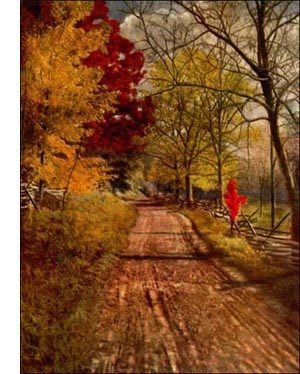Redwood Tree
 Redwood (Sequoia sempervirens, Endl.) -Resinous, aromatic trees, with tall, fluted trunks and short, horizontal branches; 200 to 300 feet high, 12 to 28 feet in diameter. Head small, irregular. Bark thick, red, 6 to 12 inches thick, in ridges 2 to q4 feet wide, checked crosswise, showing brighter, close, inner layer. Wood light, soft, brittle, close, red, easily split, durable, satiny lustre. Buds oval, small, loosely scaly. Leaves of two forms: lanceolate and spreading, or awl shaped and shorter; evergreen, 4 to 2 inch long. Flowers : moncecious, in late winter, cone shaped, scaly; staminate on erect stems, scales 3-anthered, pollen copious; pistillate with 7 ovules on each scale. Fruit oblong, woody cone, 3/4 to 1 inch long, scales thick and grooved at tip; 3 to 5-winged seeds on each. Preferred habitat, moist, sandy soil. Distribution, southern Oregon on coast range slopes to Monterey County, California. Uses: Most valuable timber tree of Pacific coast; successful in European gardens.
Redwood (Sequoia sempervirens, Endl.) -Resinous, aromatic trees, with tall, fluted trunks and short, horizontal branches; 200 to 300 feet high, 12 to 28 feet in diameter. Head small, irregular. Bark thick, red, 6 to 12 inches thick, in ridges 2 to q4 feet wide, checked crosswise, showing brighter, close, inner layer. Wood light, soft, brittle, close, red, easily split, durable, satiny lustre. Buds oval, small, loosely scaly. Leaves of two forms: lanceolate and spreading, or awl shaped and shorter; evergreen, 4 to 2 inch long. Flowers : moncecious, in late winter, cone shaped, scaly; staminate on erect stems, scales 3-anthered, pollen copious; pistillate with 7 ovules on each scale. Fruit oblong, woody cone, 3/4 to 1 inch long, scales thick and grooved at tip; 3 to 5-winged seeds on each. Preferred habitat, moist, sandy soil. Distribution, southern Oregon on coast range slopes to Monterey County, California. Uses: Most valuable timber tree of Pacific coast; successful in European gardens.In many characters, the redwood is not different from the Big Tree. Its spreading leaves on the terminal twigs give it a more graceful, feathery spray than do the awl-like blades of the other. The pistillate flowers have fewer scales, and the buds are scaly. The cones are smaller, and the seeds have more vitality. The redwood is only a trifle under the Big Tree in size, sometimes overtopping the highest of them, and reaching 400 feet. But the trunks are not so massive, and these trees average smaller than their cousins. In beauty the redwood is first; the lustrous leaves, the ruddy bark, and the gracefully curving branches of trees still in their prime will halt the passing stranger and compel his wonder and admiration. The forests throng with young trees in every stage of growth, showing that Nature left to herself would multiply and extend the range of this species. But the wood is beautiful, and light and easily worked. It is admirable in building, and durable beyond most woods. It receives a satiny polish, and it lasts indefinitely in the ground.
Curly grain is common in Sequoia lumber, and this, as in other species, is eagerly sought after by the makers of fancy furniture and bric-a-brac. People want redwood, so the lumberman is stripping the redwood forests as fast as possible. "They'll come on again!" And it is true to some extent. The trees send up suckers from the stumps, which the Big Trees cannot do. But lumbering is wasteful and greedy in its methods, and more is wasted than saved. Forest fires lick up the kindling the lumberman leaves, and young trees and old fall victims to this disaster.
Redwoods are more easily accessible than Big Trees. They come down to the coast and thus tempt the avarice of lumbermen. The extent of these woods seemed great, at first. But on the map the region is very small indeed, and immediate protective measures are demanded if any groves of big redwoods are to be saved from the sawmill.
In cultivation the redwood has followed the Big Tree into European gardens, and at length it has shown itself hardy and fairly content in the Southeastern States. Near Charleston, South Carolina, it is growing successfully.